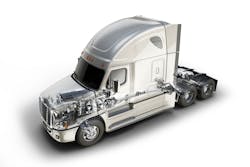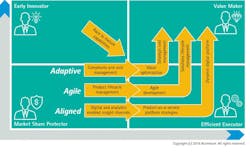Service innovation may trump product development in trucking
For time out of mind, trucking has centered on, well, trucks, trailers, and the components that make them roll: engines, transmissions, axles, wheels, tires … everything that goes into crafting a solid piece of highway iron.
Today, however, more than a few industry experts – Sandeep Kar, global vice president for research and mobility at Frost & Sullivan, is one – believe future “innovation” in trucking is not going to derive solely from building better tractors and trailers (though such product innovation isn’t going to cease, in large measure due to various regulatory initiatives).
Rather, the big “innovations” going forward will mainly occur on the services side of the industry’s ledger book.
“The digital revolution is changing the four ‘Ps’ of trucking: its processes, products, people and platforms,” he told me in a recent interview. “The single biggest thing, though, is connectivity. That’s why truck OEMs moving from a product-based to a service-based business model.”
From Kar’s perspective, every OEM will provide trucks offering great fuel economy, with driver comforts, safety systems, and the like. What will truly differentiate the many brands and models on the market, though, will be the services tied to those trucks – from maintenance diagnostic data analysis to telematics, onboard communication, infotainment options, and the like.
“For the longest time in this industry, it was all about the product,” he explained in a separate conference call with reporters hosted by research firm Stifel Capital Markets. “It was all about the truck and businesses were built around the truck. But services are now dictating how a truck should be designed. As the old saying goes, products cost money [but] services make money.”
That’s why Kar believes we are “on the cusp of that change” in the commercial vehicle industry, between products and services, with the industry now moving more toward services.
“If you take a look at how trucks are being designed today, and the kinds of technologies trucks are incorporating, the focus is on drivers, on technicians, on fleet managers, and most importantly, on the end users,” he stressed. “You will realize that a service-based economy is now front and central in the commercial vehicle industry.”
This trend is affecting every industry, by the way; not just trucking.
Take a look at this recent report issued by global consulting firm Accenture, which discerned that a focus on “distinct innovation” and services tied to product capabilities is paying off for some companies as they deliver between 3% and 7% higher annualized revenue than their peers.
The firm’s report, based on a survey of 351 companies across eight industry sectors and nine countries – Canada, China, France, Germany, Italy Japan, South Korea, the United Kingdom and the U.S. – shows that leaders are evolving their approach to innovation by developing a “total customer experience” that combines product, service, software and hardware.
In fact, two thirds (66%) of companies Accenture polled said that their most successful innovations in the last two years have been derived from improved customer experiences and related new business models versus n“It is no longer enough to build the next generation car, music player, crane or plane to satisfy customers,” stressed Richard Holman, managing director at Accenture Strategy in the report.
“Companies need to provide a superior experience to their rivals, from the point a customer shows interest in a product, through the research and purchase, to long after they own the item, with a series of services to keep the customer delighted,” he added.
“Companies across all sectors are rewriting the playbook for how they innovate and organize to drive growth, with leaders achieving between 3.5% and 7% higher revenues that are attributable to distinct approaches to innovation, product development and solution development,” Holman noted.
And there are some big dollars at stake in this business model shift, according to Accenture’s estimates.
For example, the impact of applying innovation in this way in the automotive industry could result in revenues increasing by up to $1 billion; for consumer technology, the revenue impact could be $633 million; for medical technology, it could be $581 million; and for industrial equipment manufacturers, the industry impact of innovation in this area could see a revenue increase of $567 million.
“Traditional hardware companies are being disrupted by digital technologies and are shifting their strategies to focus on software and new connected experiences,” added Holman.
“Industries ranging from sporting apparel companies, traditional toys and games, to refrigerators and other consumer durables, manufacturers are now enabling consumer services through higher level of interactivity, personalization and functionality,” he said. “For the leaders, differentiation comes from being able to go beyond asking customers what they want and instead targeting customers’ and consumers’ unmet needs.”
It’ll be interesting to see what kinds of services begin to be incorporated more frequently with trucks – and possibly even trailers – as move farther down this trend line.


